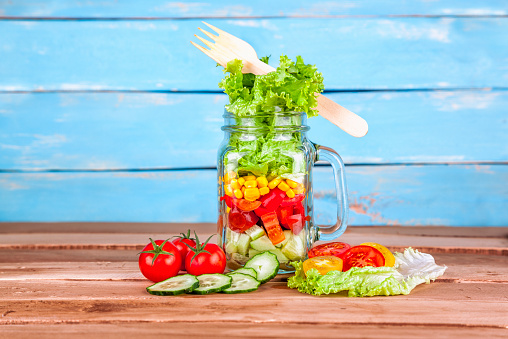
Convenient. Attractive. Normal. These three words (which are the basis for the even easier to remember acronym C.A.N.) may be the key to eating healthier without really trying, according to a recent paper from Cornell University. The review of 112 studies concluded that eaters make good choices when healthy foods are visible and within reach; they’re displayed enticingly; and they’re set up as the most obvious choices compared to other food options. It just makes sense: When you place gorgeous pieces of fresh fruit in a pretty bowl on your counter, you’re more likely to take one than if they’re hidden away—especially if the chips or cookies are even easier to grab. Bottom line, make it handy to eat healthfully and you’ll follow through, no “diet” or willpower required.
In addition to remembering C.A.N., there are plenty of other research-backed strategies for not dieting, and still shedding pounds. Here, four more easy tactics you can adopt.
Plate your veggies artistically
In a University of Oxford study, subjects in one group received salads arranged to resemble an artistic painting; a second group was provided with salads featuring vegetables lined up in neat rows, and salads in a third group were served in a typical piled-up fashion. While all the salads contained identical ingredients, dressing, and condiments, the artistic salad was rated the best by subjects, by a nearly 20 percent margin. In fact, people reported that they’d be willing to pay twice as much for the painting-like versions. The takeaway: We eat with our eyes as well as our stomachs, so if you’re trying to reach for healthy foods more often, put some effort into how you present them. (I think this study demonstrates one reason why Mason jar salads—and the myriad of photos of them on social media—have become so popular.)
Nosh before you shop
You’ve heard this one before, but it’s worth repeating: A 2013 study, also from Cornell University, found that skipping meals before heading to the supermarket is a surefire way to sabotage healthy shopping. Volunteers were asked to fast for five hours, then either given nothing to eat or crackers, and asked to make purchases at a simulated food market. The fasting group bought 18.6% more food—including a whopping 44.8% more calorie-packed items, like chips and ice cream—than the cracker eating crowd. In a follow-up study, researchers observed shoppers at an actual supermarket just after lunch and in the late afternoon. Compared to post-lunch shoppers, those who strolled the aisles in the late afternoon—when they were way more likely to be hungry—bought over a quarter fewer low-calorie foods like vegetables. To prevent hunger from keeping healthy food items out of your grocery cart, eat something to take the edge off pre-shopping. Stash a golf-ball sized portion of nuts or seeds in your bag, and try to finish them before you walk through the entrance of the supermarket.
Spend a little time in the morning sun
The timing, intensity, and length of your exposure to light during the day may significantly affect your weight. In a first-of-its-kind study, researchers at Northwestern University found that compared to people who got most of their light exposure later in the day, those who enjoyed even moderately bright light in the morning had significantly lower BMIs. In fact, the later the hour of light exposure, the higher a person’s BMI, and vice versa. The numbers held true independent of an individual’s exercise regime, calorie intake, sleep timing, and age. The powerful effect, researchers say, is due to how light influences our body’s circadian rhythms, which regulate metabolism and weight regulation. To keep those rhythms in sync and your weight in check, researchers advise getting 20 to 30 minutes of bright light exposure between 8:00 a.m. and noon. And no, you don’t have to be outdoors—a room brightened by natural sun (versus a room with no windows and only artificial light) will do.
Don’t dine while distracted
Bringing your lunch to work is a smart way to control your calories. But if you surf the Web while you eat, you may consume more than you would’ve if you’d focused on your meal, both during eating and later in the day. In a study published in the American Journal of Clinical Nutrition, people who played a computer game while lunching felt less full, snacked more, and had more trouble recalling what they had eaten than those who’d eaten without distractions. So while it may feel weird to sit at your desk without checking email or doing anything but eating, that’s the best lunchtime strategy for your waistline. Bonus: You’ll actually enjoy your lunch.
Cynthia Sass, MPH, RD, is Health’s contributing nutrition editor, and privately counsels clients in New York, Los Angeles, and long distance. Cynthia is currently the sports nutrition consultant to the New York Rangers NHL team and the Tampa Bay Rays MLB team, and is board certified as a specialist in sports dietetics.
This article originally appeared on Health.com.
More from Health.com:
More Must-Reads from TIME
- Why Biden Dropped Out
- Ukraine’s Plan to Survive Trump
- The Rise of a New Kind of Parenting Guru
- The Chaos and Commotion of the RNC in Photos
- Why We All Have a Stake in Twisters’ Success
- 8 Eating Habits That Actually Improve Your Sleep
- Welcome to the Noah Lyles Olympics
- Get Our Paris Olympics Newsletter in Your Inbox
Contact us at letters@time.com